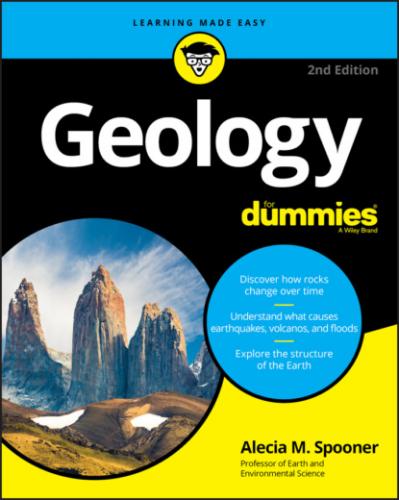Researchers have had little luck successfully predicting most destructive earthquakes. Occasionally a large earthquake will be preceded by smaller earthquakes, slight tremors, volcanic activity, or changes in land level relative to sea level. Such was the case in Haicheng, China in 1975, when warnings a day before a large earthquake occurred saved many lives. However, very few earthquakes send advance warning signals.
Current research around the Pacific Ocean focuses on trying to measure the amount of strain being put on two crustal plates as they press against one another. (When the pressure builds to a certain point and is released, an earthquake occurs; see Chapter 10 for details.) Unfortunately, many complex factors lead to an earthquake event, which makes the effort to predict them very challenging. Fortunately, scientists love a good challenge!
Climate change
In looking into Earth’s past, one area of intense study is paleoclimatology, the study of past climates. Scientists called paleoclimatologists take long, cylinder-shaped samples called cores from ice sheets. In these ice cores, they find trapped gases and dust from the ancient atmosphere that provide clues to the earth’s temperatures long ago. Similar cores of sediments in the bottom of lakes or the ocean may have fossil remains of microscopic organisms. These remains of plant and animal life help scientists called paleoecologists build a picture of the ancient environment and past climates.
These are just two of the types of records scientists use to understand Earth’s past climate conditions. By combining multiple records and including different types of data, paleoclimatologists and paleoecologists build a picture of climate change throughout Earth’s history.
Through these studies, scientists have learned that the earth’s climate has gone through dramatic shifts of warming and cooling in the past. Factors including Earth’s orbital characteristics and the position of the continents are thought to have affected the climate.
By building a more complete understanding of what changes occurred in the past, scientists hope to be able to predict what changes may occur in the future, particularly in light of industrial civilization’s measurable impacts.
Out of this world: Planetary geology and the search for life
Geology is no longer confined to Earth. Advances in scientific understanding of the earth’s planetary systems have helped scientists apply that understanding to other planets. Fields of current research include the search for extraterrestrial, or alien, life.
When astrogeologists — planetary geologists — look at the surface of Mars, they see features that remind them of features on Earth created by running water. While there is no water on Mars’s surface now, these features suggest that large amounts of water once flowed across the surface, presumably originating from underground sources on the planet.
The exploratory Mars rover project is currently collecting sediment samples and other evidence that suggest there may be water not far below the surface of Mars. New data is examined from the rovers all the time and adds to scientists’ understanding of Mars’s planetary processes.
Why does it matter if there is water on Mars (or any other planet)? One reason is that life on Earth requires water, which means if there is water on another planet, there may be life. Another reason scientists are interested in extraterrestrial water is that water will be necessary for any future human settlements on Mars. It may sound like a movie plot, but it’s real-life science!
Chapter 4
Home Sweet Home: Planet Earth
IN THIS CHAPTER
You could describe the earth as a ball of rock spinning through space, but the earth is made of much more than just rock. Planet Earth is multilayered. If you could travel from the moon to the earth’s core, you’d pass through layers that contain gas, liquid, rock, and metal. In this chapter, I briefly describe the various layers of the earth, including what scientists know about Earth’s interior layers (and how they learned about those layers).
Earth’s Spheres
The materials of Earth’s planetary system can be separated into spheres, or parts. These five major spheres of Earth’s system are illustrated in Figure 4-1:
Atmosphere: The atmosphere is a layer of gas that surrounds the entire planet. It serves the important role of protecting everything on Earth from being destroyed by the heat and radiation from the sun and makes life possible on Earth. Within the atmosphere, gases interact with water, forming weather systems that circulate air and clouds around the globe.
Hydrosphere: The hydrosphere includes all the water on Earth. The hydrologic cycle is the rotation of water through the hydrosphere: flowing as liquid (streams and rivers), evaporating into the atmosphere as gas (clouds), and falling to the surface as rain or snow.
Cryosphere: The cryosphere is composed of all the solid water, or ice, found on Earth’s surface. While closely tied to the hydrologic system, the cryosphere can be examined separately because of how massive amounts of surface ice affect the weather and climate systems.
Biosphere: All the organic materials on Earth — both living and dead organisms — are part of the biosphere.
Geosphere: The solid, rocky layers of the Earth, from the outermost crust to the very center, compose the planet’s geosphere. Within the geosphere, scientists have further divided the layers of rock material, which I describe in the next section of this chapter.
FIGURE 4-1: The five major spheres of Earth’s planetary system.
The earth’s spheres are connected to one another through a series of interactions. For example, rainfall from the hydrosphere causes movement of surface materials in the geosphere (a process called erosion, which I describe in Part 4). Rainfall also provides water for plants to grow in the biosphere. The interactions among spheres can be studied as subsystems of the earth. An example of a subsystem is the climate system, which is influenced by the interaction of atmosphere, biosphere, hydrosphere, and even geosphere.
Because Earth is one giant system, geologists study not only the rock materials on Earth but also how rocks in the geosphere interact with all the other spheres.
